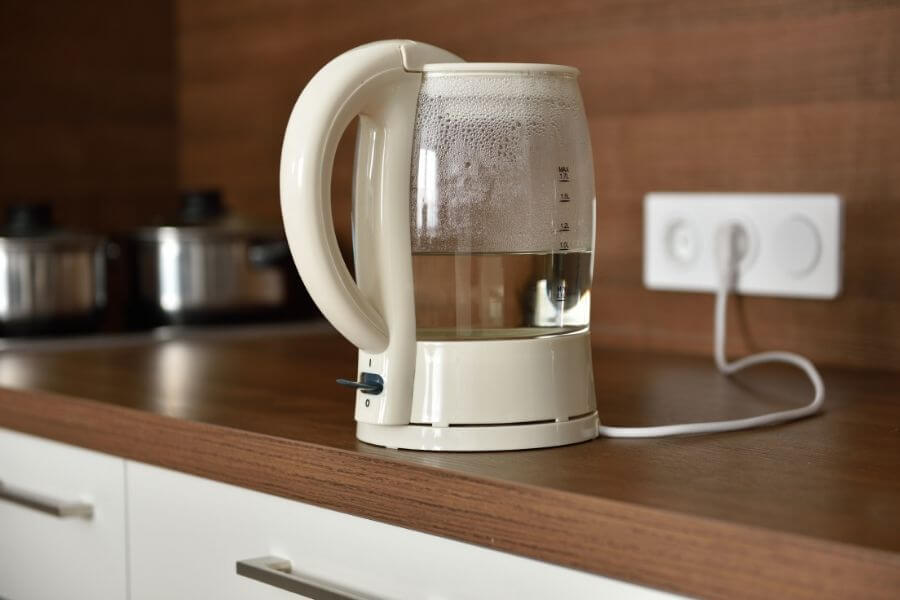How to Make a Kettle Quiet? 6 Quick and Easy Methods
For many of us, the kettle is an essential part of our lives. It’s used for making tea, coffee, hot chocolate and many other drinks. The problem? It can get noisy. Some people just don’t like noisy kettles. They love the convenience of them, but hate the noise. So, how to make a kettle quiet? And why are they noisy in the first place?

The best way is to buy a quiet kettle. Aside from purchasing an electric kettle with a larger heating element, you can reduce noise by using a tea cozy or rubberized undercoating spray to cover the kettle, or by cleaning limescale buildup within the kettle.
Read on to find out more about how they work and learn the steps you can take to quiet your kettle today.
I am an Affiliate for Amazon and other merchants, which means I may make a commission if you purchase something through the links here. There is NO extra cost to you at all, and THANK YOU so much for the support. Learn more here.
Contents: Skip to section
Hey, quick one. If you intend to start a soundproofing project soon, check out our Best Materials for Soundproofing post to get a headstart. Most projects require similar materials, so this post will save you a ton of time researching.
How do electric kettles work?
A metal coil is found inside each Kettle. This coil conducts electrical energy, which is converted to heat and used to warm the cool water inside.
The following is an example of the process:
- A large electric current travels through the coil, or ‘heating element,’ when the kettle is turned on.
- The coil has a resistance to electricity (measurement of the difficulty to pass an electric current through it). As electrical energy travels through the coil, this resistance converts it to heat.
- The heat raises the temperature of the water inside it to the point where it boils.
- Some kettles have a thermostat that tells them when the water has reached the desired temperature.
What makes electric kettles noisy?
I think the answer might bore you, but here it is.
It is due to the manner in which heat is transported into the water.
So you have an electric element within the kettle that is receiving a high current, causing it to heat up. The heat from the element is thus transferred locally by convection and conduction to the water molecules surrounding it, which become agitated and hot.
Eventually, you have a bubble of hot water surrounding the element that attempts to expand and also floats higher away from the element since warm things rise, but as it rises, it loses its heat to the surrounding water.
So this bubble of water and water vapour suddenly collapses in on itself, which is called cavitation, and you hear a jarring, knocking noise. So the thumps and sort of ‘shhh’ hissing you hear are the sound of water vapour bubbles bursting on themselves and releasing sound waves.

How loud is a kettle?
I was really surprised when I found out the answer!
Independent examinations of electric models revealed some to be noisier than a vacuum cleaner and others to be on level with a lawnmower. I mean, wow. A kettle can get as loud as some power tools!
Consumer watchdogs Which? put one kettle – the Nuo Findon – to the test and the results were pretty shocking. It reached 95 decibels, which is essentially the same as a power drill.
The noise levels of the other kettles tested varied from 79 to 95 decibels (dB), compared to 90dB for a lawnmower and 83dB for a vacuum cleaner. Because a normal conversation has a decibel level of roughly 60, a loud kettle can easily drown it out!
How to make a kettle quiet? 6 Methods explained
1. Using a tea cosy
To the younger generation, this might seem like a strange object, but in actual fact, a tea cosy is a beautiful item to use for insulation.
They are typically hand crocheted and come in a variety of shapes and styles. Some include removable padding components that may be machine washed on a regular basis.
A tea cosy keeps a teapot’s contents warm for a long period. Tea cosies, thankfully, can also assist in making a kettle quieter.
When placed on the kettle, it muffles the sounds, allowing you to boil water or make tea for as long as you wish with minimal disturbance.
Make sure the tea cozy you’re using is thick or insulated. Tea cosies are gorgeous and can bring color or character to your kitchen if you go all out with the design.
2. Use a quiet kettle
The truth is, not all kettles are made the same.
Some will have features that others don’t, and luckily for us, there are actually quiet kettles in the market.
They are typically at least 10 db quieter than regular kettles while having the exact same functions.
Most of the time, you will find that they come with a larger heating element which allows heat to disperse evenly, which means that the temperature difference between the expanded hot water and cold water is small, reducing cavitation, thus reducing noise.
Be sure to check out the best quiet electric kettles here.
3. Use a rubberized coating spray
Rubberized undercoating spray was created to protect the undersides of cars from rust while also reducing road noise, but with a little bit of imagination, you can apply it in your own too when it comes to soundproofing or insulation.
It’s virtually a permanent tea cozy in that it provides both heat and soundproofing, but the rubber material bears up to repeated heating, ensuring that your kettles remain silent throughout the day.
Spray the kettle after it has been washed and dried. Make sure to stay away from the holes and cables while doing so. The new rubberized covering aids with sound absorption.
4. Add extra padding
Try this out the next time you boil water to understand how it works.
While your kettle is boiling, lift it off the floor or a flat surface. If the noise level drops, the issue is excessive vibration which results in more noise created. Basically, more noise is bouncing off the surface on which the kettle is placed on.
The addition of padding beneath the electric kettle might make a huge difference. Use anti vibration pads or a thick, noise-reducing substance. When not in use, place the material beneath the kettle.
5. Removing limescale
As your kettle gets older, limescale or sediments might contribute to its noise.
Limescale, commonly known as calcium carbonate, is a hard deposit. It’s typically found where hot or boiling water evaporates and solidifies in difficult-to-reach spots.
When it comes into touch with water, it can give it a metallic flavor.
If your electric kettle has become noisier over time, it’s possible that the heating element has been covered with limestone, lowering the amount of surface area available to heat the water and creating cavitation (and noise) in the water.
Scrubbing alone is ineffective in removing them.
De-scaling refers to the procedure of eliminating limescale from a kettle. This solution will make your kettle quiet again.
I recommend that you try out either of these methods to descale your kettle:
- Citric acid rinse – one teaspoon of citric acid for 100 ml of water, boil and sit for 10 minutes, rinse
- Vinegar rinse – equal parts vinegar and water, sit for an hour, boil, rinse
- Lemon juice rinse – same as process for vinegar rinse
https://www.youtube.com/watch?v=Dsv6FjAjJHs
6. Switch to stainless steel or glass kettle
If you’ve done everything above and your electric kettle still isn’t quiet enough, you might want to try switching to a stainless steel kettle or a retro kettle with a lower decibel level. Those with a double-wall design, cool-touch exterior, and non-slip handles are my recommendations.
Maintenance tips to prevent kettle from becoming noisy
I would make a guess to say that most of us do not really take good care of our kettle. From the moment we buy it, it works for us without any decent clean up, let alone maintenance.
Within the first few months of use, some kettles will be completely silent.
However, things might swiftly deteriorate due to poor care.
Here are some strategies I now employ to keep my kettle running smoothly and quietly.
- After using the kettle, make sure there is no standing water in it. Mineral deposits form in the kettle as a result of this, forming calcium carbonate, and thus reducing the kettle’s ability to work correctly.
- Clean the inside and outside of the kettle once a week.
- To avoid harming the heating element in an electric kettle, do not submerge it in water.
Thanks for reading till the end. Soundproofing Hacks is supported by users like yourself. If you found our content useful, consider buying us a coffee here. It goes a long way in keeping our doors open. Thank you.
In Conclusion: How to make a kettle quiet?
Enjoying a morning brew without disturbing your sleeping family can be a reality at a low price. Try out some of the methods found above and you will definitely see some difference.
Failing which, you can always get yourself a quiet kettle, which are mostly similarly priced as regular kettles. Find out which are the best quiet kettles here.
Continue reading:

